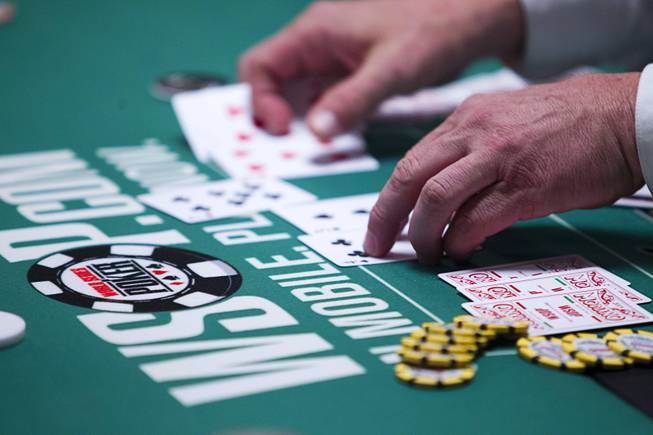
A dealer collects cards after a hand in the $565 buy-in “Colossus” event during the World Series of Poker at the Rio Monday, June 1, 2015.
Thursday, June 4, 2015 | 2 a.m.
A massive tournament billed as the largest in the history of live poker concluded at the Rio on Wednesday after a six-day run that set new records for the sport, but not without hitting some speed bumps along the way.
Thousands of players participated in the World Series of Poker’s Colossus tournament, which began Friday. It was a new event for the WSOP, and expectations were sky-high from the start: With a relatively cheap $565 buy-in, organizers suggested beforehand that the Colossus could be the biggest tournament ever.
They weren’t disappointed. Yet an undertaking this large was bound to encounter a few obstacles.
For the Colossus, size was a problem for those who were disappointed that the winner — who ended up being Cord Garcia of Houston — didn’t walk away with a bigger prize. And cashing players out efficiently when the tournament was still thousands strong proved to be a major logistical challenge.
“It was a very ambitious thing,” WSOP Executive Director Ty Stewart said of the Colossus. “Overall, we were pleased, but we know we can get better.”
Here are some of the major takeaways from the historic tournament.
It set some important new records.
The 22,374 official entries in the Colossus far surpassed the previous record-holder for largest live poker tournament ever. That title was formerly held by the Main Event at the 2006 WSOP, which had 8,773 entries.
The WSOP was quick to draw favorable comparisons between the tournament and other major events. Tournament organizers said in a statement that the Colossus entrants numbered more than the on-site viewers of the recent Mayweather-Pacquiao fight, for example, which was seen by a full crowd at the 16,800-seat MGM Grand Garden Arena.
“It’s just a jaw-dropping result,” Stewart said of the Colossus turnout. “I hope it gives poker enthusiasts a lot of pride.”
The Colossus set a few other records, too, according to the WSOP. It boasted the best single-day attendance ever with 12,172 entries on Saturday (following 10,202 on Friday).
Its 2,241 players who won cash also beat the previous record of 873 set by the 2006 Main Event.
And the tournament’s $11,187,000 prize pool was larger than any other live poker event with a buy-in of less than $5,000, while its $638,880 first-place prize was the highest ever for a $500 buy-in event.
But some people were sorely disappointed with the top prize.
Those last two records are at the heart of a big issue that many poker players and fans had with the tournament. Simply put, they were disgruntled that the cash prize for the top winner was so far under $1 million, given the size of the total prize pool.
The poker website Poker News Daily explained that, at 5.7 percent of the pool, the prize for the winner was “a far cry from the usual payout for a major poker tournament and probably well under what many of the participants in the event were expecting.”
That sentiment was reflected clearly on Twitter.
Stewart responded to the blowback in his own series of tweets.
He told players and fans that it would have been worse to give a bigger payday to the winner and pay less to the thousands of others who played in the tournament. And many people did walk away with cash, with the lowest prize coming in at $1,096 for 2,241st place.
“We really thought the tragedy and the outrage would have come if we would have stolen from thousands of players at the bottom or middle of the payout scale just to have a big, splashy, sexy headline at first place,” Stewart said. “There is no perfect science for poker tournament payouts. It’s part art and part science. But nobody has ever seen anything like paying out 2,200 folks.”
Also, some people were perfectly content with the prize.
Garcia wasn’t upset with his $638,880 prize after he won Wednesday.
“I think, for the overall best interest of the game, it’s definitely good,” he told reporters. “A bunch of people got paid a lot of money.”
WSOP doesn’t know yet whether Colossus will return next year.
Concern about the top prize wasn’t the only problem organizers faced. Stewart admitted that although getting the tournament up and running went pretty well, some players waited far too long to get their money in the beginning.
“While we got an ‘A’ for getting them in and getting them through, we might have gotten an ‘F’ for getting them out and getting them paid,” he said. “We’re giving ourselves an average grade with a lot of room for improvement.”
Given all that, Stewart said he’s not sure right now whether the Colossus will return next year, though he indicated that he would like to see it happen again.
“If we feel that we can do it better than we’ve done in a way that’s really going to guarantee repeat visitation, it’ll come back,” he said. “And if we felt like we bit off more than we can chew under the current constraints, then it won’t.”
In the meantime, the current WSOP presses on with its other events, culminating in the Main Event later this summer.

Join the Discussion:
Check this out for a full explanation of our conversion to the LiveFyre commenting system and instructions on how to sign up for an account.
Full comments policy